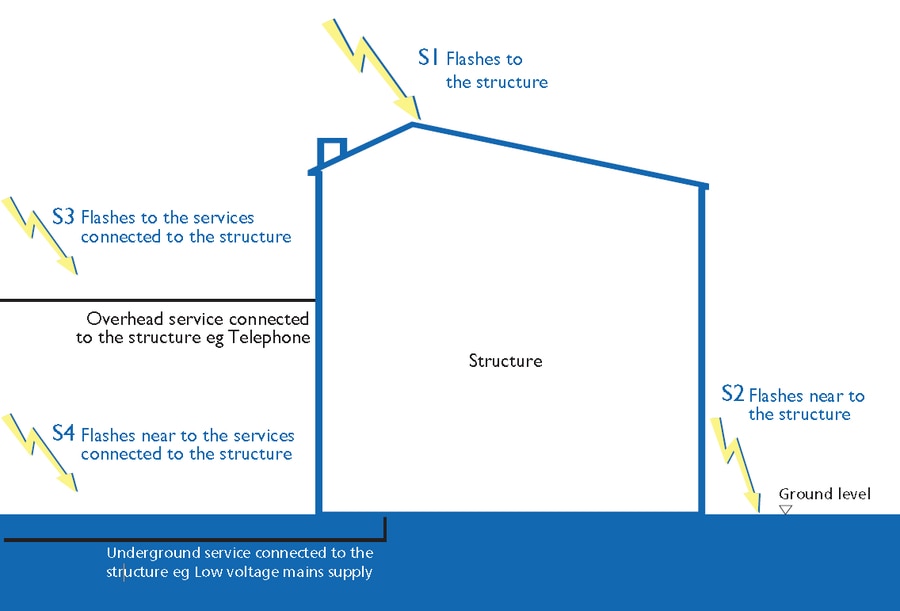
#White Papers
EN 62305
The EN 62305 standard series specifically cover the protection against lightning to structures, their contents, persons and livestock.
EN 62305 accepts that we now live in the electronic age, making LEMP (Lightning Electromagnetic Impulse) protection for electronic and electrical systems an integral part of the standard through EN 62305-4. LEMP is the term given to the overall electromagnetic effects of lightning, including conducted surges (transient overvoltage and currents) and radiated electromagnetic field effects.
EN 62305 – 4 categorizes the source of damage, type of damage and the type of loss.
Sources of damage
Damage that can be caused by lightning is sub-divided into:
• Damage to a structure (including all incoming electrical overhead and buried lines connected to the structure)
• Damage to a service (service in this instance being part of telecommunication, data, electrical supply, water, gas and fuel distribution networks).
Types of damage
Each source of damage may result in one or more of three types of damage. The possible types of damage are identified as follows:
D1 Injury of persons or livestock due to step and touch voltages
D2 Physical damage (fire, explosion, mechanical destruction, chemical release) due to lightning current effects including sparking
D3 Failure of internal systems due to Lightning Electromagnetic Impulse (LEMP).
Types of loss
The following types of loss may result from damage due to lightning:
L1 Loss of human life
L2 Loss of service to the public
L3 Loss of cultural heritage
L4 Loss of economic value
LEMP damage is so prevalent that it is identified as one of the specific types (D3) against which protection should be provided and can occur from ALL strike points to the structure or connected services – direct or indirect. This extended approach also takes into account the danger of fire or explosion associated with services connected to the structure, e.g. power, telecoms and other metallic lines.
EN 62305 makes it clear that structural lightning protection must no longer be considered in isolation from transient overvoltage/surge protection and given that lightning from all strikes points, direct or indirect, to the structure or connected services creates a risk from transients, SPDs are a vital means of protection whether structural lightning protection is present or not.
Current and voltage waveforms
EN 62305 takes account of protection measures on metallic service lines (typically power, signal and telecom lines) using transient overvoltage or Surge Protection Devices (SPDs) against both direct lightning strikes as well as the more common indirect lightning strikes and switching transients. Standards such as the EN 61643 series define the characteristics of lightning currents and voltages to enable reliable and repeatable testing of SPDs (as well as lightning protection components). Although these waveforms may differ from actual transients, the standardized forms are based upon years of observation and measurement (and in some cases simulation). In general they provide a fair approximation of the real world transient.
Transient waveforms have a fast rising edge and a longer tail. They are described through their peak value (or magnitude), rise time and their duration (or fall time). The duration is measured as the time taken for the test transient to decay to half its peak value.
Direct strikes
Direct lightning can inject partial lightning currents of the 10/350μs waveform into a system where a structure with a structural Lightning Protection System receives a direct strike (Source S1) or where lightning directly strikes an overhead service line (Source S3).
Indirect strikes
Remote or indirect lightning flashes near the structure (Source S2) or near a connected service to the structure (Source S4) of up to 1km radius away (and hence far more common) are represented by the 8/20μs waveform. Induced surges from direct lightning flashes and switching sources are also represented by this waveform. With a much shorter decay or fall time relative to the 10/350μs waveform, the 8/20μs waveform presents significantly less energy (for an equivalent peak current) but is still devastating enough to damage electrical and electronic equipment.
EN 62305-1 recognizes that failure of internal systems (Damage Type D3) due to Lightning Electromagnetic Impulse (LEMP) is possible from all points of strike to the structure or service – direct or indirect (all Sources: S1, S2, S3 and S4).
Surge Protection Measures (SPM)
EN 62305-4 describes a number of measures to minimize the severity of transient overvoltage caused by lightning and electrical switching.
Key and basic protection measures are:
• Earthing and bonding
• Electromagnetic shielding and line routing
• Coordinated Surge Protective Devices
Further additional protection measures include:
• Extensions to the structural LPS
• Equipment location
• Use of fiber optic cables (protection by isolation)






